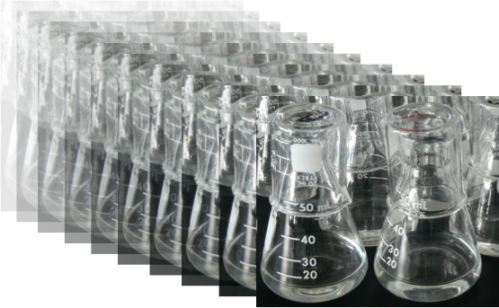The E. coli long-term evolution experiment (LTEE) began in 1988, and it has run for over 32 years with only occasional interruptions. The latest interruption, of course, reflects the temporary closure of my lab during the ongoing coronavirus pandemic. Fortunately, one of the advantages of working with bacteria is that we can freeze population samples and later revive them, which will allow us to resume their daily propagation when it is prudent to do so. Indeed, we’ve frozen samples of all 12 populations throughout the LTEE’s history, allowing “time travel” to measure and analyze their fitness trajectories, genome evolution, historical contingencies, and more.
Even as the experiment is on ice, the lab team continues to analyze recently collected data, prepare papers that report their findings, and make plans for future work. Their analyses use data collected from the LTEE itself, as well as from various experiments spun off from the LTEE. Nkrumah Grant is writing up analyses of genomic and phenotypic aspects of metabolic evolution in the LTEE populations. Kyle Card is examining genome sequences for evidence of historical contingencies that influence the evolution of antibiotic resistance. Zachary Blount is comparing the evolution of new populations propagated in citrate-only versus citrate + glucose media. Minako Izutsu is examining the effects of population size on the genetic targets of selection, while Devin Lake is performing numerical simulations to understand the effects of population size on the dynamics of adaptive evolution. So everyone remains busy and engaged in science, even with the lab temporarily closed.
Today, I’m excited to announce two new developments. First, the National Science Foundation (NSF) has renewed the grant that supports the LTEE for the next 5 years. This grant enables the continued propagation of the LTEE lines, the storage of frozen samples, and some core analyses of the evolving populations. The grant is funded through the NSF’s Long Term Research in Environmental Biology (LTREB) Program, which “supports the generation of extended time series of data to address important questions in evolutionary biology, ecology, and ecosystem science.” Thank you to the reviewers and program officers for their endorsement of our research, and to the American public and policy-makers for supporting the NSF’s mission “to promote the progress of science.”
Second, Jeff Barrick joins me as co-PI on this grant for the next 5 years, and I expect he will be the lead PI after that period. In fact, Jeff and his team will take over the daily propagation of the LTEE populations and storage of the sample collection even before then. I’m not planning to retire during the coming grant period. Instead, this transfer of responsibility is intended to ensure that the LTEE remains in good hands for decades to come. In the meantime, Jeff’s group will conduct some analyses of the LTEE lines even before they take over the daily responsibilities, while my team will continue working on the lines after the handoff occurs.
Several years ago I wrote about the qualifications of scientists who would lead the LTEE into the future: “My thinking is that each successive scientist responsible for the LTEE would, ideally, be young enough that he or she could direct the project for 25 years or so, but senior enough to have been promoted and tenured based on his or her independent achievements in a relevant field (evolutionary biology, genomics, microbiology, etc.). Thus, the LTEE would continue in parallel with that person’s other research, rather than requiring his or her full effort, just like my team has conducted other research in addition to the LTEE.”
Jeff is an outstanding young scientist with all of these attributes. Two years ago he was promoted to Associate Professor with tenure in the Department of Molecular Biosciences at the University of Texas at Austin. He has expertise in multiple areas relevant to the LTEE including evolution, microbiology, genomics, bioinformatics, biochemistry, molecular biology, and synthetic biology. He directs a substantial team of technicians, postdocs, and graduate students, which will provide ample coverage for the daily LTEE transfers (including weekends and holidays). Last but not least, Jeff has participated in the LTEE and made many contributions to it including:
- Participated in propagating the LTEE lines and related activities while he was a postdoc in my lab from 2006 to 2010.
- Authored many papers using samples from the LTEE, including almost all of them that have analyzed genome sequences as well as several recent papers examining the genetic underpinnings of the ability to use citrate that evolved in one lineage.
- Developed the open-source breseq computational pipeline for comprehensively identifying mutations that distinguish ancestral and evolved genomes.
Someone might reasonably ask if the LTEE will work in the same way when it is moved to another site. The answer is yes: the environment is simple and defined, so it is readily reproduced. Indeed, I moved the LTEE from UC-Irvine to MSU many years ago, the lab has moved between buildings here at MSU, and we’ve shared strains with scientists at many other institutions, where measurements and inferences have been satisfactorily reproducible. As an additional check, Jeff’s team at UT-Austin ran a set of the competition assays that we use to measure the relative fitness of evolved and ancestral bacteria, and we compared the new data to data that we had previously obtained here at MSU. The two datasets agreed well, in line with the inherent measurement noise in assessing relative fitness. Fitness is the most integrative measure of performance of the LTEE populations, and it is potentially sensitive to subtle differences in conditions. These results provide further evidence that, when the time comes, the LTEE can continue its journey of adaptation and innovation in its new home.
Evolve, LTEE, evolve!


Pingback: Links 5/13/20 | Mike the Mad Biologist